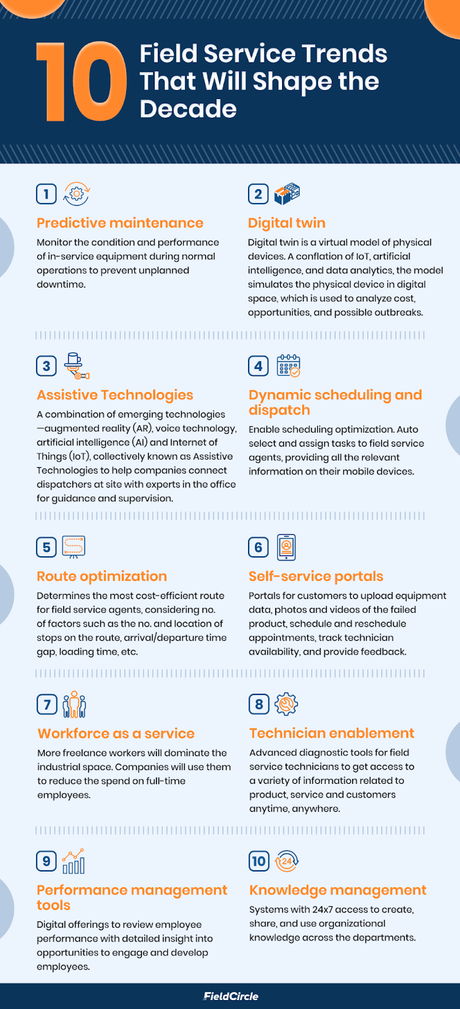What will the future of field service look like by 2030?
For many, 2030 is a distant future, but for those who are responsible for shaping the direction of the company, it is not the time far away. And for that, they generally take critical decisions now to transform the organization.
It not only keeps them aligned with disruption happening in the industry but also helps figuring out the white spaces where nothing much is happening at the moment.
On the contrary, as pointed out by the Silicon Valley tech entrepreneur, Kim Polese, “The short-term thinking disease is everywhere you look.” It traps the leadership executives in determining tactical responses for the current challenges instead of taking actions for the future. The difference in approach could be seen as:
Defining priorities and allocating resources Pursue research for new investments
Personnel changes—hiring, layoffs, quits, promotions, acquisitions, and organizational changes. Workforce development for future needs
Makeshift technology changes that may impact ROI and business’ key KPIs in present Technology selection and adoption based on how technology will be used a couple of years down the line and not the current trends
In order to make the shift, you must engage yourself in developing a “clear vision for industry’s evolution”, according to this HBR article. In that process, if we take a look at the current “sustainable innovations” in the field service industry, it would give us a preview of how the industry may evolve. Here is an infographics of current field service trends that will shape this decade and trigger impactful evolutions in the next one.

Let us dissect each of these field service trends to see how these trends are setting in and the responses of the field service leaders.
1. Predictive Maintenance
The global predictive maintenance market size is expected to grow at a compound annual growth rate (CAGR) of 25.2% during the forecast period, from USD 4.0 billion in 2020 to USD 12.3 billion by 2025, according to marketsandmarkets research. The increasing pressure on companies in MRO sectors to reduce the maintenance downtime and the cost of operations are the major factors that are driving this growth.
In this YouTube by Google Work Space, Prashant Dinghra, Machine Learning Lead, Advanced Solutions Lab, Google Cloud, explains how you can create a hypothesis and build data models around it to develop the predictive maintenance capabilities, mainly to:
- Predict if equipment will fail in the next ‘N’ period
- Predict if equipment will fail in the next ‘N1’, ‘N2’…period
- Predict if the equipment will fail in the next ‘N’ period due to the fault in the part ‘X’
- Predict the time to failure or remaining life of equipment
- Find anomalies
In the same video, Manju Devdas, founder and CEO of Pluto7, also explains how predictive maintenance “makes your operations and monitoring team more productive” and saves money by reducing unforeseen downtime.
2. Digital Twin
Digital twin is a conflation of AI, ML, and IoT technologies to collect, process, and then drill down data to get actionable insight. It is basically creating a digital clone of the systems, products, and processes to analyze the implications of any action on them in the real-world environment.
The global Digital Twin market is expected to grow at a CAGR of more than 24.7% during the forecast period 2021 to 2026, as reported by IndustryARC. Interestingly, 42% of market growth is expected to take place in North America, especially in the automobile and aerospace industries.
While it has a number of applications in product design and development and business optimization, maintenance operations is leading the segment by 24%, closely followed by performance monitoring.
3. AR and VR for Remote Assistance
A survey by Gartner in 2018 found that “AR use has increased by 15% and now 1 in 4 field service organizations are driving AR implementations.”
In the field service industry, AR and VR technologies are used to create a simulated environment derived from real world scenarios. It enables service technicians to visualize and identify the problem beforehand, so that they could go prepared at the client’s location with tools and essential spare parts, while also allowing them to connect with certified experts from remote locations to seek guidance and support.
One of the biggest developments in remote assistance is Microsoft’s Hololens. According to Alex Kipman, the person in charge of the HoloLens project, Hololens is for the “people that have been, in a sense, neglected or haven’t had access to technology [in their hands-on jobs] because PCs, tablets, phones don’t really lend themselves to those experiences.” It will improve collaboration across locations and facilitate access and exchange of data to resolve the issues quickly and accurately.
4. Dynamic Scheduling and Dispatch
Scheduling and dispatch processes act as the connective tissue between field service technicians and the back-office staff. Any error or mismanagement at this point is quickly reflected as the loss of productivity and poor first-time fix rate.
In an article published by McKinsey on How Disruptive Technologies are Opening up Innovative Opportunities in Services, it is stated that “By using data and telematics to track technicians schedules in real time’, companies can add 20 to 30 percent to the working day.”
Similarly, Deloitte stated that companies are “Reducing costs by optimizing dispatch processes through employing information such as skills, proximity, priority, account allocations for scheduling and dispatch.”

5. Route Optimization
The global route optimization software market is expected to grow at a CAGR of 11.4% from USD 2.50 billion in 2017 to USD 5.07 billion by 2023. The growth rate signals how companies are using geographic information systems (GIS) technology to optimize routes and save time and the fuel cost.
Route optimization software solutions enable the users to select fuel-efficient routes, track drive time, and prevent unplanned stops within the service delivery network. Usually such software solutions consist of a powerful route optimization engine that tests multiple scenarios to check the time and cost factors to make best route recommendations.
6. Customer Self-service Portals
According to ResearchAndMarkets.com, the customer self-service software market was valued at USD 7.20 billion in 2019, and it is expected to register a CAGR of 20.94% during the forecast period from 2020 to 2025.
Self-service portals for customers provide information and tools that enable them to schedule technician appointments in their own time, locate technicians, and provide feedback on the job done by them. There are two incredible benefits of deploying self-service portals:
- It provides more control to the customers in deciding on when and how they want to be served.
- It could help you build a community around your product/service to effectively engage your customers with more resourceful content and other activities.
Well, the self-service economy might grow much faster than you expect, considering that “70% of customers expect a company’s website to have a self-service portal,” according to Steven Van Belleghem, Global keynote speaker. A similar study conducted by DimensionData reported that “73% of customers prefer to use a company’s website, instead of using social media, SMS and live chat for support.”
7. Workforce as a Service
The global consulting firm McKinsey reported that there are approximately “68 million freelancers in the US.” Most of the gig workers are supporting B2C models, working for companies such as Uber, Lyft, TaskRabbit, Instacart, Airbnb and Shyp. As the technology is evolving the FSM processes, the field service industry too is expected to see a rise in freelance technicians and contractors.
IBM in an article, How the gig economy will transform field service management, stated that “companies can more accurately predict outages and deploy their workforce” with “systems to track work orders and maintenance records for all field infrastructure.”
These systems make it possible for the field service companies to provide role-based permissions for anytime, anywhere accessibility of information to their freelance technicians. So while the technicians could access information to complete maintenance/repair tasks, companies have more control over who and how much information a freelance technician must see.
8. Technician Enablement Tools
To have a clear understanding of technical enablement tools, you need to see the whole FSM process from field service technicians’ perspective. A human and not a resource and that requires an acceptance that they are prone to fatigue, frustrations, and mistakes. Facilitating them with tools that share their burden and support them during tough times is the next step post acceptance.
For instance, diagnostic tools could provide them with information such as service manuals, service history, suggestions for diagnosis and repair, and the relevant service manual to solve the issue accurately. As stated by Deloitte in the article, Smart Field Service “Creating the right experiences for your field technicians is essential in delivering delightful experiences for your customers.”
Yogesh Choudhary, CEO at FieldCircle, elaborates on this as, “The people critical to your business success are out in the field and their empowerment can not only provide immense business and customer insights but can simply be transformative for your service business.”
9. Performance Management Tools
A typical FSM process requires performance evaluation of people, processes and assets. Most of the field service organizations use KPIs or metrics to evaluate the performance. Some of the top KPIs, according to the Field Service News report, include customer satisfaction, service revenue, mean time to repair, SLA compliance, field technician utilization rate, and service part revenue.
As the companies would move their processes online, it would increase the adoption of performance management tools to set, define, monitor, and measure KPIs, be it of assets or field teams or so on.
Currently, the global asset performance management market is expected to grow at a CAGR of 10.7% to reach a market value of 18, 765 million in 2025. On the same line, the global field service management market size is expected to grow from USD 3.0 billion in 2020 to USD 5.1 billion by 2025, at a Compound Annual Growth Rate (CAGR) of 11.0% during the forecast period.
10. Knowledge Management
The efforts to prevent the loss of knowledge with an aging workforce, high employee turnover, and operational complexity would increase in the field service industry. According to the Field Service News report, “48% of field service companies the threat of an aging workforce was indeed a genuine threat to their service operations.”
However, it may be one of the reasons for knowledge management. Another critical reason for increased knowledge management efforts in the industry is improved first-time fix rate. By making critical information such as service manuals associated with work orders accessible for technicians in the field, companies have a better opportunity to ensure quick and accurate resolution of the problem.
An Afterthought
What seems “nice to have” may become “must-have” in the blink of an eye considering the rapid changes in the technology and the acceptance of technology solutions among consumers. And these disruptions, most times, lead to businesses going out of business because they fail to adapt and adopt.
Now is the time to start thinking about what may happen 4 or 6 or 10 years down the line in your industry and plan in advance- to be ahead in the game, serve your customers better and build a business that is a disruptor.
Author's Latest Articles
-
Build Vs Buy the Software: A Detailed Decision-making Framework
-
9 Habits of Service Technicians That Affect Customer Experience Negatively
-
10 Service Technician Soft Skills That Can Transform Your Business
-
Growth Mindset in Service Technicians: How It Can Transform Your Service Business

